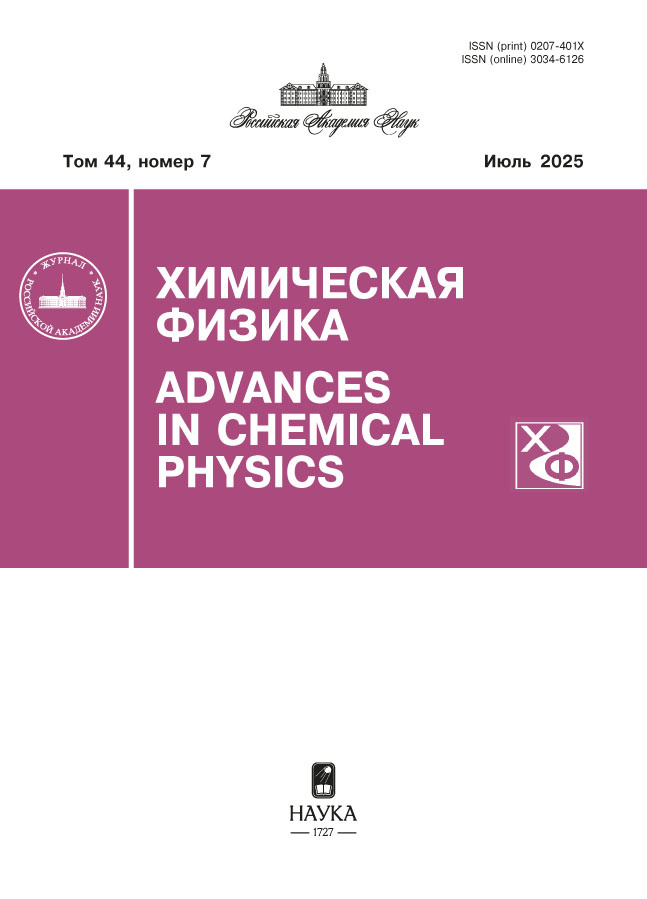Converging Cylindrical Detonation Wave: Numerical Modeling and Experiment
- 作者: Sultanov V.G.1, Dudin S.V.1, Sosikov V.A.1, Torunov S.I.1, Vasilenok E.V.2, Rapota D.Y.1, Razmyslov A.V.1
-
隶属关系:
- Federal Research Center of Problems of Chemical Physics and Medicinal Chemistry of the Russian Academy of Sciences
- Moscow Institute of Physics and Technology
- 期: 卷 44, 编号 7 (2025)
- 页面: 64-72
- 栏目: Combustion, explosion and shock waves
- URL: https://ruspoj.com/0207-401X/article/view/687629
- DOI: https://doi.org/10.31857/S0207401X25070075
- ID: 687629
如何引用文章
详细
Numerical modeling of formation and propagation of detonation wave with concave curvature was conducted in present work. The modeling follows experiments where detonation of cylindrical explosive charge is initiated by multiple 3D-printed initiation modules. Specific experiments were used to adjust parameters of the equation of state of charge explosive and of lenses material employed. The modeling has revealed main features in performance of single initiation module and of an initiation module installed in an experimental setup. Possibility of formation of “smooth” converging detonation wave was confirmed empirically.
全文:
作者简介
V. Sultanov
Federal Research Center of Problems of Chemical Physics and Medicinal Chemistry of the Russian Academy of Sciences
编辑信件的主要联系方式.
Email: sultan@ficp.ac.ru
俄罗斯联邦, Chernogolovka
S. Dudin
Federal Research Center of Problems of Chemical Physics and Medicinal Chemistry of the Russian Academy of Sciences
Email: sultan@ficp.ac.ru
俄罗斯联邦, Chernogolovka
V. Sosikov
Federal Research Center of Problems of Chemical Physics and Medicinal Chemistry of the Russian Academy of Sciences
Email: sultan@ficp.ac.ru
俄罗斯联邦, Chernogolovka
S. Torunov
Federal Research Center of Problems of Chemical Physics and Medicinal Chemistry of the Russian Academy of Sciences
Email: sultan@ficp.ac.ru
俄罗斯联邦, Chernogolovka
E. Vasilenok
Moscow Institute of Physics and Technology
Email: sultan@ficp.ac.ru
俄罗斯联邦, Dolgoprudny
D. Rapota
Federal Research Center of Problems of Chemical Physics and Medicinal Chemistry of the Russian Academy of Sciences
Email: sultan@ficp.ac.ru
俄罗斯联邦, Chernogolovka
A. Razmyslov
Federal Research Center of Problems of Chemical Physics and Medicinal Chemistry of the Russian Academy of Sciences
Email: sultan@ficp.ac.ru
俄罗斯联邦, Chernogolovka
参考
- Medvedev S.P., Khomik S.V., Maximova O.G. et al. // Russ. J. Phys. Chem. B. 2023. V. 17. № 4. P. 962 https://doi.org/10.1134/S1990793123040279
- Medvedev S.P., Ivantsov A.N., Anderzhanov E.K. et al. // Russ. J. Phys. Chem. B V. 16. № 6. P. 1137. https://doi.org/10.1134/S1990793122060197
- Zeldovich Ya.B. // JETP. 1942. V. 12. № 9. P. 389
- Dudin S.V., Sosikov V.A., Torunov S.I. // J. Phys.: Conf. Ser. 2017. V. 946. 012057. https://doi.org/10.1088/1742-6596/946/1/012057
- Shutov A.V., Sultanov V.G., Dudin S.V. // J. Phys.: Conf. Ser. 2016. V. 774. 012075. https://doi.org/10.1088/1742-6596/774/1/012075
- Sosikov V.A., Torunov S.I., Dudin S.V. // J. Phys.: Conf. Ser. 2018. V. 1147. 012027. https://doi.org/10.1088/1742-6596/1147/1/012027
- Dudin S.V., Sosikov V.A., Torunov S.I. // J. Phys.: Conf. Ser. 2016. V. 774. 012074. https://doi.org/10.1088/1742-6596/774/1/012074
- Gubachev V.A., Bondarenko N.M., Fillipov V.A., Galkin E.A. Device to generate blast wave. Patent RU2451895C1. Russia // 2012.
- Krutik M.I., Arinin V.A., Ткаченко B.I., Dudin S.V. // Combustion and explosion. 2024. V. 17. № 2. P. 78. https://doi.org/10.30826/CE24170212
- Heylmun J., Vonk P., Brewer T. blastFoam: An OpenFOAM Solver for Compressible Multi-Fluid Flow with Application to High-Explosive Detonation. Synthetik Applied Technologies LLC. 2019.
- Heylmun J., Vonk P., Brewer T. blastFoam User Guide. Synthetik Applied Technologies LLC. 2019.
- Utkin A.V., Mochalova V.M., Torunov S.I. // Russ. J. Phys. Chem. B. 2011. V. 5. № 3. P. 513.
- Ermolaev B.S., Komissarov P.V., Basakina S.S., Lavrov V.V. // Russ. J. Phys. Chem. B 2023. V. 17. № 5. P. 1143. https://doi.org/10.1134/S1990793123050020
- Ermolaev B.S., Komissarov P.V., Basakina S.S., Lavrov V.V. // Russ. J. Phys. Chem. B 2024. V. 18. № 2. P. 494. https://doi.org/10.1134/S1990793124020076
- Dobratz B.M. LLNL Explosive Handbook: Properties of Chemical Explosives and Explosive Simulants. L.: LLNL. 1981.
- Sultanov V.G., Dudin S.V., Sosikov V.A. et al. // Combust. Explos. Shock Waves. 2023. V. 59. № 4. P. 516. https://doi.org/10.1134/S0010508223040159
- Dudin S.V., Sosikov V.A., Torunov S.I. // Combust. Explos. Shock Waves. 2019. V. 55. № 4. P. 507. https://doi.org/10.1134/S0010508219040191
补充文件
















